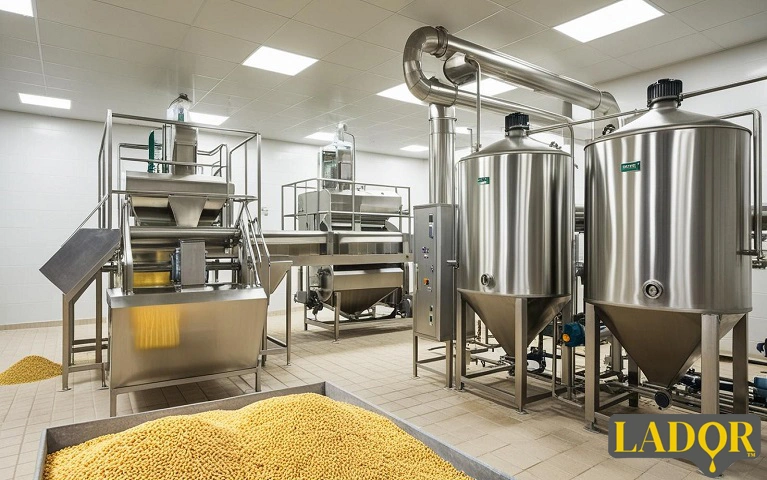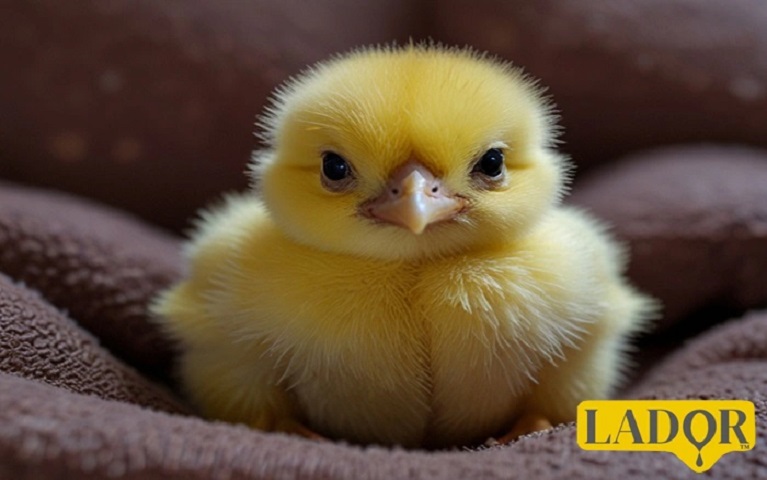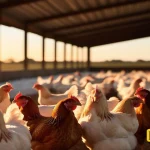colored chicken feed, especially in the first few weeks of life, plays a crucial role in the healthy and rapid growth of chicks. These feeds are specifically formulated to meet all the nutritional needs of chicks. Chicks require a special diet to grow well and develop a strong immune system. For this reason, it’s important to use ready-made chick-colored feed. It is both nutrient-rich and easily digestible for newborn chicks. To learn more about chick starter feed, continue reading.
Key Components of Colored Chick Feed
- Proteins: Primarily sourced from plants like soy and animals such as meat and fish. Proteins are essential for the growth of muscles, feathers, and other bodily tissues.
- Carbohydrates: Mainly derived from corn, wheat, and barley. Carbohydrates serve as the primary energy source for chicks.
- Fats: Obtained from plant-based sources like soybean oil and sunflower oil, as well as animal-based sources like meat fat. Fats are crucial for vitamin absorption, energy production, and body insulation.
- Vitamins and Minerals: Encompassing a wide range of vitamins such as A, D, E, and K, and minerals including calcium, phosphorus, and zinc. These nutrients are vital for proper bodily function, immune system strengthening, and bone growth.
- Additives: Certain additives like enzymes, probiotics, and antibiotics may be included in the feed to enhance digestion, boost the immune system, and prevent diseases.
Production Process of Chick Starter Feed
- The feed formula is carefully designed based on the specific nutritional requirements of chicks of different ages and breeds.
- The raw materials are weighed according to the formula and thoroughly mixed.
- The mixed ingredients are ground to a fine consistency to ensure proper digestion.
- The ground feed is pressed into pellets to improve handling, reduce dust, and encourage consumption.
- The pellets are cooled to prevent spoilage.
- The final product undergoes rigorous quality control testing to ensure it meets the required nutritional standards and is free of contaminants.
Conditions for keeping colored chickens
Maintenance environment
- Suitable Temperature: Chicks need a warm environment. In the first week, the ambient temperature should be around 35 degrees Celsius and then gradually reduced to room temperature. You can use special chick brooder lamps or heating pads to provide heat.
- Sufficient Light: Chicks need enough light to eat well and grow. Use special chick brooder lamps with red or white light.
- Adequate Space: Each chick needs enough space to move and grow. Use chick brooders that are large enough.
- Soft Bedding: Cover the bottom of the brooder with soft shavings, straw, or sawdust to protect the chicks’ feet.
Feeding
- Chick Starter Feed: The best food for chicks is a special chick starter feed that you can buy from pet stores.
- Clean and Fresh Water: Always provide chicks with clean and fresh water.
- Grated Boiled Egg: Boiled eggs are a good source of protein and are very beneficial for chick growth.
- Chopped Vegetables: Chopped vegetables such as lettuce and parsley can also be given to chicks as a dietary supplement.
Hygiene
- Clean Environment: Clean the chick’s environment regularly to prevent the growth of bacteria.
- Regular Bedding Change: Change the bedding every few days.
- Wash Food and Water Containers: Wash food and water containers regularly.
Other Important Points
- Isolate Sick Chicks: Isolate sick chicks from other chicks to prevent the spread of disease.
- Consult a Veterinarian: If you notice any signs of illness in the chicks, consult a veterinarian.
- Pay Attention to Chick Behavior: Pay attention to the chicks’ behavior to notice any changes.
What food should we give colored chickens?
- Chick Starter Feed: The best option for feeding chicks is a special chick starter feed that you can buy from pet stores. These feeds contain all the nutrients chicks need in the early stages of growth.
- Homemade Mixture: If you don’t have access to a special feed, you can use a mixture of the following ingredients:
- Wheat bran
- Crushed corn
- Soybeans
- Flaxseed
- Chopped vegetables (such as lettuce, parsley)
- Soft fruits (such as apples, bananas)
- Grated boiled eggs: Eggs are a good source of protein and are very beneficial for chick growth.
- Clean and fresh water: Always provide chicks with clean and fresh water.
Note: In large poultry farms, Special aviculure oil is used for chickens at the right time.
What Foods are Harmful to Colored Chicks?
- Avocado: All parts of the avocado are toxic to birds.
- Coffee and Tea: The caffeine in coffee and tea is harmful to birds.
- Chocolate: Chocolate contains compounds that are dangerous to birds’ hearts.
- Onions and Garlic: Onions and garlic can cause anemia in birds.
- Alcohol: Alcohol, even in small amounts, is toxic to birds.

Proper Nutrition for Colored Chicks at Different Ages
Proper nutrition is a key factor in the healthy growth of colored chicks. The nutritional needs of chicks vary at different ages.
- First few weeks: During this period, chicks need high protein for rapid growth. A special chick starter feed containing essential proteins, vitamins, and minerals is the best option.
- Following weeks: As chicks grow older, you can gradually reduce the amount of protein and use a feed specifically for older chicks.
- Adulthood: Adult chicks need feed that contains a balanced mix of nutrients to maintain health and reproduction.
Important Tips for Feeding
- Clean and fresh water: Always provide chicks with clean and fresh water.
- Vegetables and fruits: Offer green leafy vegetables and soft fruits like apples and bananas as a dietary supplement for chicks.
- Boiled eggs: Grated boiled eggs are a good source of protein.
- Vitamins and minerals: To ensure that chicks receive all the necessary nutrients, you can use special bird vitamin supplements.
Common Diseases in Colored Chicks
Colored chicks, like other birds, are susceptible to certain diseases. Knowing these diseases and their symptoms will help you take timely action if a problem arises.
- Coccidiosis: This is a parasitic disease of the intestines and causes bloody diarrhea, lethargy, and weight loss.
- Candidiasis (Thrush): This is a fungal disease that appears as white spots on the mouth and throat.
- Newcastle Disease: A highly contagious viral disease that can cause death in chicks.
- Gumboro Disease: Another viral disease that weakens the chicks’ immune system.
- Salmonella: A bacterial disease that causes diarrhea, lethargy, and weight loss.
Symptoms of Disease in Chicks
- Lethargy and reduced activity: One of the first signs of illness in chicks.
- Decreased appetite: Sick chicks usually have no appetite.
- Changes in droppings: Diarrhea, constipation, or changes in the color of droppings can be a sign of illness.
- Changes in feathers: Ruffled feathers, feather loss, and changes in feather color are symptoms of disease.
- Changes in breathing: Rapid and difficult breathing can be a sign of respiratory diseases.
Treatment of Diseases
- Consult a veterinarian: For an accurate diagnosis and appropriate treatment, be sure to consult a veterinarian.
- Prescribed medications: The veterinarian will prescribe appropriate medications based on their diagnosis.
- Environmental hygiene: Keep the chicks’ environment clean and disinfected.
- Isolate sick chicks: Isolate sick chicks from other chicks to prevent the spread of disease.
Transferring Colored Chicks to a Larger Environment
Transferring colored chicks to a larger environment is an important stage in their growth. This allows the chicks to move around more, spread their wings, and develop their social skills. However, this transfer should be done carefully and with planning to prevent stress and disease in the chicks.
Appropriate Time for Transfer
- Suitable age: Usually, when the chicks are old enough and their feathers have grown, they can be transferred to a larger environment. This is usually about 4 to 6 weeks after birth.
- Suitable season: The best time for transfer is during the warm seasons so that the chicks can easily adapt to the new environment.
Preparing the New Environment
- Clean and disinfect: Before transferring the chicks, thoroughly clean and disinfect the new environment to prevent any contamination.
- Provide shelter: Create shelters for the chicks in the new environment, such as wooden or plastic boxes with small holes so the chicks can rest.
- Provide water and food: Place water and food containers in different places so that all chicks can easily access them.
- Provide light and heat: If necessary, use heat lamps to keep the environment at a suitable temperature for the chicks.
Transfer Stages
- Preparing the Chicks: Before transferring, ensure the chicks are healthy and active.
- Gentle Transfer: Transfer the chicks to the new environment gently and carefully.
- Monitoring Chick Behavior: Closely monitor the chicks’ behavior during the first few days to ensure they are adapting to the new environment.
- Providing Security: Design the new environment to protect the chicks from predators and other environmental factors.

Important Points in Feeding Colored Chicks
- Chicks should be fed regularly at specific intervals.
- When changing the diet, do so gradually to allow the chicks’ digestive systems to adjust to the new feed.
- Keep the chicks’ living environment clean to prevent diseases.
- Feed the chicks in appropriate amounts to avoid food waste and environmental contamination.
- You can use special bird vitamin supplements to boost the chicks’ immune system.
Summary
Chick starter feed is a highly specialized product formulated to meet all the nutritional needs of chicks during the early stages of growth. The composition and production process of these feeds is designed to ensure maximum growth and health of the chicks.
In the Ala Sepahan oil factory, all kinds of prepared poultry feed such as; One-day-old chicken feed, colored chicken feed, local chicken ready feed, etc. are produced.



